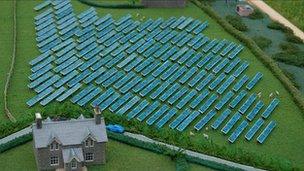Solar power farms face cash cut, government warns
- Published

Farms threaten to milk the system of cash
The government is acting to stop a proliferation of solar power farms.
It says they threaten to use up too much of the money set aside to fund the new system of "feed-in tariffs".
These tariffs are the cash subsidies given to people who generate electricity by putting solar panels or wind turbines on their homes.
Energy Secretary Chris Huhne says big solar farms threaten to use up the available cash for homes and small businesses who want to use the system.
Last October planning permission was granted for the UK's first purpose-built solar farm, in Cornwall, and with up to 6,000 individual panels.
"Because of the risk of an increasing number of large scale solar farms which could push feed-in tariffs (FITs) off track, and the need to give industry added certainty to invest, the coalition is today announcing a comprehensive review into the scheme," said Mr Huhne.
"Large scale solar installations weren't anticipated under the FITs scheme we inherited and I'm concerned this could mean that money meant for people who want to produce their own green electricity has the potential to be directed towards large scale commercial solar projects."
Concern
The system of feed-in tariffs was first launched in April 2010 by the previous Labour government.
However there has been growing concern that the system might be milked by businesses which simply install solar panels on a large scale over fields.
The issue was highlighted in January by the BBC Money Box programme on Radio 4.
"There have been some very ambitious statements from large companies about the size of solar exploitation," Greg Barker, the Minister for Energy and Climate Change told the programme.
Although the FITS scheme will now undergo a "comprehensive" review, to report by the end of this year, the government said there would be a much quicker enquiry into large scale generators which produce more than 50 kW - the output of about 20 typical homes under the scheme.
Schemes above this size now face a change to their tariffs "as soon as practicable" the Department of Energy and Climate Change (DECC) said.
Existing tariffs for everyone else are scheduled to stay as they are until April 2010, unless the review also reveals "a need for greater urgency," DECC added.
Output
So far about 21,000 schemes are registered to take advantage of the FIT scheme, which has just under £400m allocated to it.
The vast majority of these are homes and use photovoltaic solar panels.
Friends of the Earth (FoE) said feed-in tariffs had been a great success and argued they should not be restricted.
"The government should be planning to expand the scheme, not holding a knee-jerk review aimed at applying the financial brakes," said FoE.
"This review is exactly the kind of move that will kill off the confidence of investors who have flocked to take advantage of the scheme."
The typical home installation produces about 2.5 kW.
Homeowners are told they can earn £800 a year from their tariff payments, based on the subsidy of 41.3p per kilo watt hour.
This payment is index-linked and guaranteed for 25 years, and households also save an estimated £120 a year from lower heating bills.
However the homeowners who take part have to pay for the cost of installing the equipment, which can be about £10,000.
At present the maximum size of an installation under the FIT scheme is five megawatts (5,000 kW).
- Published29 January 2011
- Published24 January 2011
- Published16 December 2010
- Published9 November 2010
- Published1 September 2010